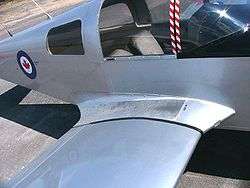Wing root
The wing root is the part of the wing on a fixed-wing aircraft or winged-spaceship that is closest to the fuselage.[1] On a simple monoplane configuration, this is usually easy to identify. However, on parasol wing or multiple boom aircraft, the wing may not have a distinct root area.[1] The opposite end of a wing from the wing root is the wing tip.[1]

The aerodynamic properties of the overall aircraft can be greatly impacted by the shaping and other design choices of the wing root.[2] During both normal flight and landings, the wing root of an aircraft would be typically subjected to the highest bending forces through the aircraft. As a means of reducing interference drag between the wing and the fuselage, the use of fairings (often referred to as "wing fillets") became commonplace during the first half of the twentieth century;[3][4] the use of wing root fairings has been credited with achieving more favourable flight characteristics at both high and low speeds.[5] Furthermore, various other innovations and approaches have been developed to influence/control airflow in the vicinity of the wing root to achieve more favourable performance.[6] Various calculating methods for designed an optimal wing root of an aircraft have been devised.[7][8]
Fatigue has been recognised as a critical life-limiting factor associated with the wing root, which will eventually lead to catastrophic failure if not monitored.[9] Accordingly, it is commonplace within an aircraft's maintenance regime to mandate periodic assessments of the wing root to check for fatigue cracking and other signs of strain. For this purpose, the use of appropriately-applied strain gauges has become widespread, although alternative methods of detection have also been used.[10][11]
The complexity of the wing root can be greatly increased by the desired role and performance requirements of the aircraft in question. For instance, numerous naval aircraft intended for use at sea have incorporated wing-folding mechanisms into their wing roots, necessitating the installation of a hinge and other compromises to allow for folding.[12] Other examples of specific needs include the presence of high-lift devices, which can be installed around the wing root for increased generation of lift as well as to optimize load distribution.[13] In the case of very high speed hypersonic aircraft, the wing root is judged to be a critical structural areas in terms of its heat migration and dissipation properties.[14]
See also
References
- Peppler, I.L.: From The Ground Up, page 9. Aviation Publishers Co. Limited, Ottawa Ontario, Twenty Seventh Revised Edition, 1996. ISBN 0-9690054-9-0
- Ibrahim Halil Guzelbey, Yüksel Eraslan and Mehmet Hanifi Doğru (March 2019). "Effects of Taper Ratio on Aircraft Wing Aerodynamic Parameters: A Comperative Study".CS1 maint: uses authors parameter (link)
- "US2927749A: Airfoil wing root fillet". Google. 1956.
- Garrison, Peter (February 2019). "The Perfect Airplane Wing". Air & Space Magazine.
- "Wing Root Fairings". utdallas.edu. Retrieved 16 June 2020.
- "US6152404A: Apparatus for influencing a wing root airflow in an aircraft". Google. 1997.
- Sobieczky, H (1998). "Configuration test cases for aircraft wing root design and optimization". International Symposium on Inverse Problems in Engineering Mechanics. pp. 371–380.
- Large, E (March 1981). "The optimal planform, size and mass of a wing". Cambridge University Press. pp. 103–110.
- Yousefirad, Behzad (1 January 2005). "Fatigue response of aircraft wing root joints under limit cycle oscillations". Ryerson University.
- Lindauer, Jason M. (June 2010). "F/A-18(A-D) Wing Root Fatigue Life Expended (FLE) Prediction without the use of Stain Gage Data" (PDF). Naval Postgraduate School.
- Waruna Seneviratne, John Tomblin, Gayanath Aponso, Travis Cravens, Madan Kittur and Anisur Rahman (September 2011). "Durability and Residual Strength Assessment of F/A-18 A-D Wing-Root Stepped-Lap Joint". Aerospace Research Centre.CS1 maint: uses authors parameter (link)
- Samuel Adam Schweighart, Carl Curtis Dietrich, Andrew Heafitz (2008). "US20100019080A1: Folding Wing Root Mechanism". Google.CS1 maint: uses authors parameter (link)
- Mahfad, Hicham (29 August 2019). "WO2019164385 - Wing Root High-Lift System with Mobile Fuselage Wing". patentscope.wipo.int.
- Schwarz, Arman (2014). "Experimental Study of Hypersonic Wing/Fin Root Heating at Mach 8". University of Queensland.